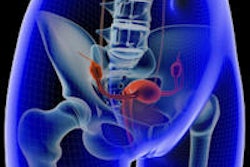
NEW YORK (Reuters Health) - Women can safely get pregnant and deliver healthy babies after undergoing uterine artery embolization for fibroids, researchers from Portugal report in a September 25 online paper in Fertility and Sterility.
"Pregnancy is possible after uterine fibroid embolization, although it cannot be guaranteed," lead author Dr. Joao M. Pisco from St. Louis Hospital and New University of Lisbon told Reuters Health by e-mail.
Ideally, Dr. Pisco said, the procedure "should be performed by experienced interventionists with caution, using low x-ray doses, low fluoroscopy times, and limited embolization in order to embolize only tumor vessels, sparing the normal uterus vessels."
The retrospective case series report by Dr. Pisco and colleagues reviews their experience between June 2004 and March 2009 with uterine fibroid embolization in 74 women who wanted to become pregnant.
There have already been reports that uterine artery embolization can leave fertility intact, but most studies involved fewer women. Earlier this year, French researchers reported (in the same journal) on 14 women who needed this procedure for refractory postpartum hemorrhage but still wished for another child. Twelve became pregnant; the other two were each more than 40 years old (see Reuters Health story of May 27, 2010). According to a paper from Spain last year, the risk of ovarian failure is "negligible" in uterine fibroid embolization patients who are younger than 40 (see Reuters Health story of January 8, 2009).
For the current study, the authors used polyvinyl alcohol particles or Embozene Microspheres (CeloNova) to embolize the uterine arteries, with nonfilling of the small arterial branches to the fibroids as the end point for embolization. Some large arterial branches were left open to avoid overembolization.
They advised the women to wait at least six months before trying to conceive; nevertheless, pregnancies occurred as early as two months and as late as 24 months after embolization.
During 4.5 years of follow-up, 44 women (59.5%) became pregnant spontaneously (i.e., without medically assisted reproductive techniques).
Thirty-nine of the 44 pregnancies were completed; the other five were ongoing at the time of the report.
Among the 39 completed pregnancies were 33 successful live births (84.6%), four spontaneous abortions (10.3%), one induced abortion, and one stillbirth at 36 weeks of pregnancy.
Two of the spontaneous abortions were in women who had multiple spontaneous abortions before the embolization procedure, the researchers note.
Patients with successful live births ranged in age from 29 to 43 years (mean, 36 years). The degree of ischemia of the dominant fibroid after embolization was over 90% in all these patients.
Twenty-five of the 33 successful live births were the first child. Most (20) occurred during the first year, with the remainder occurring during the second year after embolization.
A third of the births were by vaginal delivery, and two-thirds were by cesarean delivery. Only five newborns (15.2%) had low birth weights, and there were two cases of placenta previa (6.1%).
The rate of low birth weight deliveries, investigators say, is the same as that for women in the general population in their late 30s, and the preterm delivery rate matches that in the general population.
Dr. Pisco said, "The indications for surgical myomectomy are: patients with no more than three small or medium size myomas whose removal will be possible without hysterectomy. The indications for uterine fibroid embolization are: patients who had previous failed myomectomy, with more than three myomas, or if hysterectomy cannot be excluded either by the size of the myomas or by its localization."
"The patients should undergo MRI at six months after embolization in order to check if all the fibroids are in total ischemia before they try to get pregnant," he continued. "After embolization, the patients don't need to do any medically assisted procedure to get pregnant."
Dr. Pisco added that he would like to investigate which particle size will be better for a successful pregnancy and whether fluoroscopy-time, x-rays dose, and degree of embolization are important prognostic factors.
By Will Boggs, MD
Source: http://link.reuters.com/det38p
Fertil Steril 2010.
Last Updated: 2010-10-15 10:00:01 -0400 (Reuters Health)
Related Reading
For persistent fibroids, a less invasive option, July 28, 2010
UFE fertility rates compare to surgery, March 15, 2010
Uterine fibroid embolization does not accelerate ovarian reserve decline, January 27, 2010
Laparoscopically assisted cryoablation effective for uterine fibroids, December 29, 2009
Hysterectomy most cost-effective fibroid treatment, March 20, 2009
Copyright © 2010 Reuters Limited. All rights reserved. Republication or redistribution of Reuters content, including by framing or similar means, is expressly prohibited without the prior written consent of Reuters. Reuters shall not be liable for any errors or delays in the content, or for any actions taken in reliance thereon. Reuters and the Reuters sphere logo are registered trademarks and trademarks of the Reuters group of companies around the world.



















